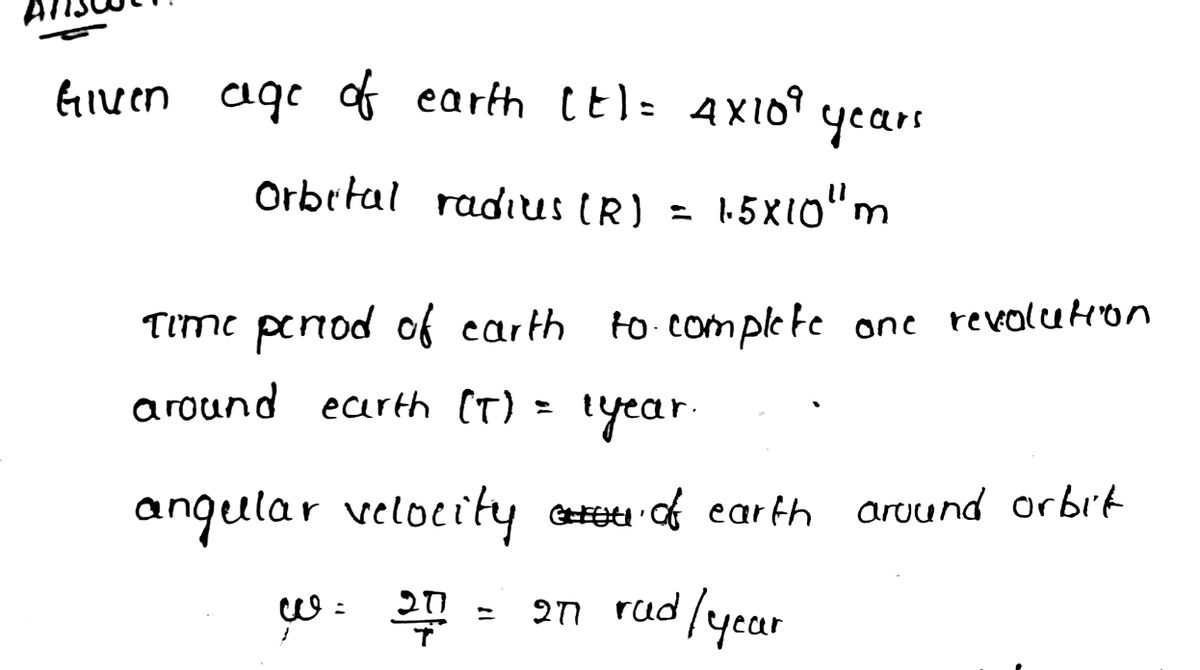
College Physics
11th Edition
ISBN: 9781305952300
Author: Raymond A. Serway, Chris Vuille
Publisher: Cengage Learning
expand_more
expand_more
format_list_bulleted
Question
Taking the age of Earth to be about 4×1094×109 years and assuming its orbital radius of 1.5×1011 m1.5×1011 m has not changed and is circular, calculate the approximate total distance Earth has traveled since its birth (in a frame of reference stationary with respect to the Sun
Expert Solution
arrow_forward
Step 1

Step by stepSolved in 2 steps with 2 images

Knowledge Booster
Learn more about
Need a deep-dive on the concept behind this application? Look no further. Learn more about this topic, physics and related others by exploring similar questions and additional content below.Similar questions
- A new planet is discovered orbiting a distant star. Observations have confirmed that the planet has a circular orbit with a radius of 12 AU and takes 117 days to orbit the star. Determine the mass of the star. State your answer with appropriate mks units. [NOTE: AU ..stands.for...astronomical unit". It is the average distance between Earth & the Sun. 1 AU≈ 1.496 x 1011 m.] Enter a number with units. I be quite large and your calculator will display the answer as a power of 10. If, as an example, your answer was 8.54 x 1056, you would type "8.54e56" into the answer box (remember to state your units with your answer).]arrow_forwardTaking the age of Earth to be about 4 ✕ 109 years and assuming its orbital radius of 1.5 ✕ 1011 m has not changed and is circular, calculate the approximate total distance Earth has traveled since its birth (in a frame of reference stationary with respect to the Sun).arrow_forwardThe speed of light is about 3 x 108 meters per second. The Millennium Falcon is traveling from Earth to Mars at the speed of light. The distance between the Earth and Mars fluctuates between 5.46 x 10¹0 meters and 4,01 x 10¹¹ meters. If the day the Millennium Falcon makes the "Mars Run," the distance is 2.25 x 10¹¹ meters, how long will it take them? Note: distance = rate time, and time = distance/rate Express your answer in scientific notation. Use for the multiplication. seconds Convert your answer to minutes. Include at least 3 decimal places in your answer, which can be expressed in standard notation. minutes Suppose the Millennium Falcon flies for 5 hours at the speed of light. How far will they travel? Express your answer in scientific notation. metersarrow_forward
- need help with this questionarrow_forwardAccording to Lunar Laser Ranging experiment the average distance LM from the Earth to the Moon is approximately 3.92 x 105 km. The Moon orbits the Earth and completes one revolution relative to the stars in approximately 27.5 days (a sidereal month). Calculate the orbital velocity of the Moon in m/s. Answer: Choose...arrow_forward. The drawing represents two suspended spheres. The force of gravity between the two spheres is 12 N (newtons). If the mass of each sphere is doubled (2x), and the distance between the spheres remains constant, what will happen to the force of gravity?arrow_forward
- Use Kepler's Law, which states that the square of the time, T, required for a planet to orbit the Sun varies directly with the cube of the mean distance, a, that the planet is from the Sun.Using Earth's time of 1 year and a mean distance of 93 million miles, the equation relating T (in years) and a (in million miles) is 804375T2=a3.Use that relation equation to determine the time required for a planet with mean distance of 206 million miles to orbit the Sun. Round to 2 decimal places. yearsarrow_forwardexpress the speed of light (c = 2.9979 x 10^8 m/s) in km/year (take note that there is a leap year every 4 years, i.e. an additional day is added to the total calendar days every four years)arrow_forwardOne full year is 365.26 days. Using this number and the distance between the sun and the earth, calculate the Earth’s velocity. Question 8 options: 21.4 km/s 23.7 km/s 26.2 km/s 29.8 km/s 31.9 km/sarrow_forward
- Taking the age of Earth to be about 4 ✕ 109 years and assuming its orbital radius of 1.5 ✕ 1011 m has not changed and is circular, calculate the approximate total distance Earth has traveled since its birth (in a frame of reference stationary with respect to the Sun). ..............m Answer and simplifyarrow_forwardThe gravitational force between two objects that are 2.2x10^-1m apart is 3.1x10^-6N. If the mass of one object is 45 kg what is the mass of the other object?arrow_forward
arrow_back_ios
arrow_forward_ios
Recommended textbooks for you
 College PhysicsPhysicsISBN:9781305952300Author:Raymond A. Serway, Chris VuillePublisher:Cengage Learning
College PhysicsPhysicsISBN:9781305952300Author:Raymond A. Serway, Chris VuillePublisher:Cengage Learning University Physics (14th Edition)PhysicsISBN:9780133969290Author:Hugh D. Young, Roger A. FreedmanPublisher:PEARSON
University Physics (14th Edition)PhysicsISBN:9780133969290Author:Hugh D. Young, Roger A. FreedmanPublisher:PEARSON Introduction To Quantum MechanicsPhysicsISBN:9781107189638Author:Griffiths, David J., Schroeter, Darrell F.Publisher:Cambridge University Press
Introduction To Quantum MechanicsPhysicsISBN:9781107189638Author:Griffiths, David J., Schroeter, Darrell F.Publisher:Cambridge University Press Physics for Scientists and EngineersPhysicsISBN:9781337553278Author:Raymond A. Serway, John W. JewettPublisher:Cengage Learning
Physics for Scientists and EngineersPhysicsISBN:9781337553278Author:Raymond A. Serway, John W. JewettPublisher:Cengage Learning Lecture- Tutorials for Introductory AstronomyPhysicsISBN:9780321820464Author:Edward E. Prather, Tim P. Slater, Jeff P. Adams, Gina BrissendenPublisher:Addison-Wesley
Lecture- Tutorials for Introductory AstronomyPhysicsISBN:9780321820464Author:Edward E. Prather, Tim P. Slater, Jeff P. Adams, Gina BrissendenPublisher:Addison-Wesley College Physics: A Strategic Approach (4th Editio...PhysicsISBN:9780134609034Author:Randall D. Knight (Professor Emeritus), Brian Jones, Stuart FieldPublisher:PEARSON
College Physics: A Strategic Approach (4th Editio...PhysicsISBN:9780134609034Author:Randall D. Knight (Professor Emeritus), Brian Jones, Stuart FieldPublisher:PEARSON

College Physics
Physics
ISBN:9781305952300
Author:Raymond A. Serway, Chris Vuille
Publisher:Cengage Learning

University Physics (14th Edition)
Physics
ISBN:9780133969290
Author:Hugh D. Young, Roger A. Freedman
Publisher:PEARSON

Introduction To Quantum Mechanics
Physics
ISBN:9781107189638
Author:Griffiths, David J., Schroeter, Darrell F.
Publisher:Cambridge University Press

Physics for Scientists and Engineers
Physics
ISBN:9781337553278
Author:Raymond A. Serway, John W. Jewett
Publisher:Cengage Learning

Lecture- Tutorials for Introductory Astronomy
Physics
ISBN:9780321820464
Author:Edward E. Prather, Tim P. Slater, Jeff P. Adams, Gina Brissenden
Publisher:Addison-Wesley

College Physics: A Strategic Approach (4th Editio...
Physics
ISBN:9780134609034
Author:Randall D. Knight (Professor Emeritus), Brian Jones, Stuart Field
Publisher:PEARSON